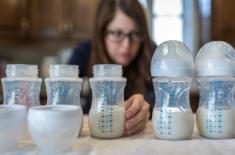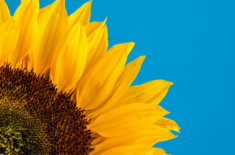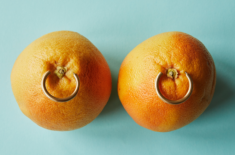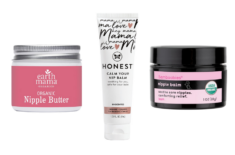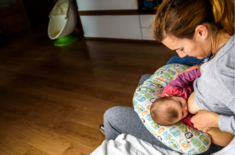Do You Burn Calories When You Breastfeed?
Yes. Milk production requires a lot of energy. Your body burns calories to produce breastmilk. But can you lose weight while breastfeeding?
Studies show that exclusive breastfeeding can increase a new mom’s probability of returning to pre-pregnancy weight than non-exclusive breastfeeding (mix of nursing and using infant formula). (1)(2)
How Many Calories Are In Breastmilk?
An ounce of breast milk contains around 20 calories. (3)
How Many Calories Does Breastfeeding Burn?
Your body burns around the same amount of calories to create that much breastmilk.
So, you’ll burn around 20 calories for each ounce of breastmilk you produce. The amount varies for each feeding session, but you can estimate the calories in terms of how much your child drinks.
Depending on your baby’s needs, you’ll burn around 425 to 700 calories per day. (4)
The actual calories you burn depends on several factors, including the following:
- Breastfeeding frequency – Exclusive breastfeeding burns more calories than if you’re combining nursing and formula feeding.
- Milk production – You’ll burn more calories with an overabundant breastmilk supply than if you have a low milk supply.
- Your baby’s age – You’ll be breastfeeding less frequently when you start weaning as your baby begins eating solid foods.
Do You Burn More Calories If You Make More Breastmilk?
Yes. The amount of calories you burn is directly proportional to the amount of breastmilk you produce.
Although it’s difficult to measure if you’re breastfeeding directly, if you’re pumping, then you can calculate based on how much you pumped.
For example, if you’re pumping around 20 oz of breastmilk a day:
- 20 calories per oz x 20 oz = 400 calories
If you’re giving mixed feeds and pumping around 10 oz a day:
- 20 calories per oz x 10 oz = 200 calories
However, this is just a rough estimate.
According to studies, the efficiency of breast milk production ranges from around 80% to 95%. You might be burning more than 20 calories to make 1 oz. (5)
How Many Calories Does Breastfeeding Twins Burn?
Your body adjusts milk production based on your baby’s needs. With twice the number of breastfed babies when you have twins, you’ll burn about twice the number of calories.
So, if you’re burning around 425 to 700 calories per day for one baby, it’ll be around 850 to 1,400 calories per day for exclusively breastfeeding your twins.
How Can You Calculate For Produced Milk If You’re Breastfeeding?
You can try measuring your baby’s body weight before and after feeding.
Amount of breastmilk = Final baby weight – Initial baby weight
To calculate the calories burned, you can use the formula: 20 calories per oz x the answer.
How Many Calories Does 30 Minutes Of Breastfeeding Burn?
It depends on how much milk your baby feeds on in 30 minutes (typical feeding session). It varies with their age and feeding needs.
According to the AAP (American Academy of Pediatrics), these are the estimated volumes per feeding session: (6)
- Newborns (first few days) – around ½ oz
- Newborns (first two weeks) – around 1-2 oz
- Newborns (up to two months) – around 2-3 oz
- 2+ months – around 4-5 oz
- 4+ months – around 4-6 oz
- 6+ months – around 8 oz
You can calculate the calories using the formula above.
Do You Lose More Weight Breastfeeding Or Pumping?
There’s no difference between the calories needed for milk production in either practice, but the actual amount you burn depends on how much you’re breastfeeding or pumping. It follows the same rule as above.
What’s A Good Diet For Breastfeeding Moms?
Eat a balanced diet to provide your baby with the nutrients their body needs for healthy growth and development.
To meet lactation demands and maintain breast milk supply, nursing mothers need to increase their caloric intake by around 500 calories per day (or more, depending on your baby’s feeding needs). (4)
A non-nursing woman needs around 2,500 calories per day. This means that your daily calorie intake should increase to around 3,000 calories or more when breastfeeding.
However, getting enough calories isn’t the only factor to consider. These additional calories shouldn’t be “empty” calories like junk food and sweets. (4)
It’s good to fill your extra calorie intake with healthy foods or snacks, like fruits (such as bananas, apples, and watermelon), peanut butter, and yogurt.
The calories you need can also vary, depending on these factors:
- Your age and activity level (including exercise and doing chores)
- Exclusive breastfeeding or mixed feeding with infant formula
- How often you’re breastfeeding
- How many babies you’re nursing or pumping for
- You’re a teen mom
- You’re following a vegan or vegetarian diet
- You have diabetes (high blood sugar)
Foods rich in proteins, iron, calcium, and vitamins can help stimulate breast milk production. Some examples are: (7)
- Fennel (seeds or oil)
- Flaxseed or flaxseed meal (ground flaxseed)
- Whole grains such as whole oats, rolled oats, or oat flour
- Organic chia seeds
- Red, yellow, or orange vegetables: beets, carrots, and yams
- Dark, leafy green vegetables: spinach, arugula, collard greens, Swiss chard, and kale
- Fresh fruits: green papaya
- Legumes: lentils and chickpeas
- Nuts and seeds: walnuts, cashews, macadamia nuts, and sesame seeds
- Fried fruits
- Eggs
- Citrus fruits
- Lean meats
- Low-mercury seafood
- Dairy
If your baby develops a rash, diarrhea, congestion, or fussiness after breastfeeding, talk to your pediatrician because they might be allergic to one of the foods in your diet.
Foods To Avoid Or Limit
- Gassy foods – cabbage, cauliflower, and brussels sprouts
- High-mercury fish – king mackerel, swordfish, and tilefish
- Juices and sugary drinks (can also lead to weight gain)
- Limit caffeine intake (e.g., coffee, tea, etc.) to around two to three cups daily.
It’s best to avoid regular alcohol intake. For occasional drinks, ACOG (American College of Obstetricians and Gynecologists) and La Leche League recommend waiting at least two hours from drinking alcohol before breastfeeding your baby. (8)
How Much Water Should I Drink While Breastfeeding?
Breastfeeding mothers need to drink water frequently or around eight cups (2 quarts) daily. To help you keep track of your water intake, you can drink a glass of water every feeding session.
What Happens If You Don’t Eat Enough While Breastfeeding?
Breastmilk remains nutritious even if you’re not eating enough. However, eating less or skipping meals for postpartum weight loss can decrease your milk supply.
Milk production can use up your fat stores, affecting your health and energy reserves. (9)
To help you lose weight, eliminate processed carbs like sugary snacks, bread, and pasta.
Health Benefits Of Breastfeeding
According to ACOG, breastfeeding can: (10)
- Make it easier for you to lose pregnancy weight gain
- Reduce postpartum bleeding by releasing oxytocin, a hormone that makes your uterus contract and help return it to its pre-pregnancy size
- Reduce risks of breast and ovarian cancers, type 2 diabetes, arthritis, obesity, osteoporosis, and high blood pressure (11)
REFERENCES
(1) https://www.ncbi.nlm.nih.gov/pmc/articles/PMC4312189/
(2) https://www.ncbi.nlm.nih.gov/pmc/articles/PMC6520964/
(3) https://hhma.org/healthadvisor/pa-forminst-pep/
(4) https://americanpregnancy.org/healthy-pregnancy/breastfeeding/diet-considerations-while-breastfeeding/
(5) https://pubmed.ncbi.nlm.nih.gov/1959517/
(6) https://www.healthychildren.org/English/ages-stages/baby/feeding-nutrition/Pages/How-Often-and-How-Much-Should-Your-Baby-Eat.aspx
(7) https://www.chop.edu/pages/diet-breastfeeding-mothers
(8) https://www.laleche.org.uk/alcohol-and-breastfeeding/
(9) https://www.laleche.org.uk/breastfeeding-and-a-mothers-diet-myths-and-facts/
(10) https://www.acog.org/womens-health/faqs/breastfeeding-your-baby
(11) https://www.diabetes.org/diabetes/gestational-diabetes/diabetes-breastfeeding



